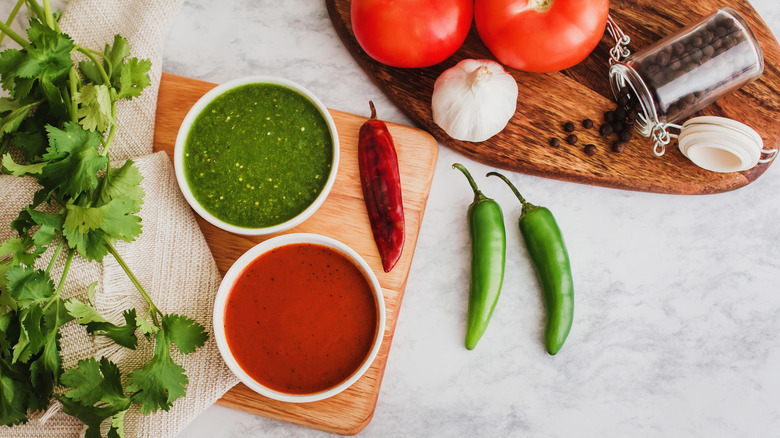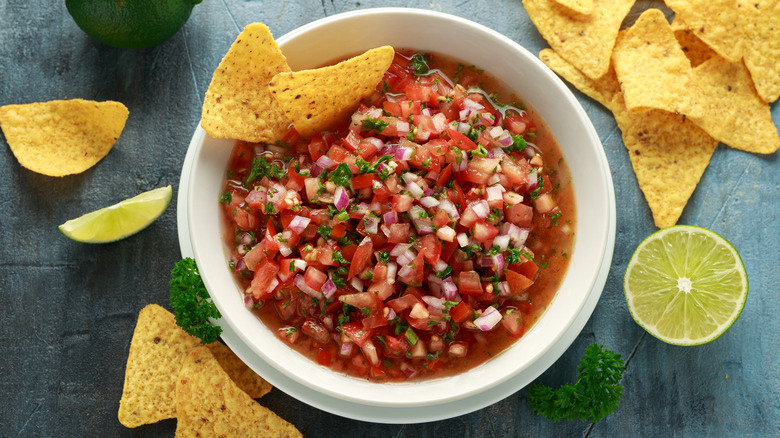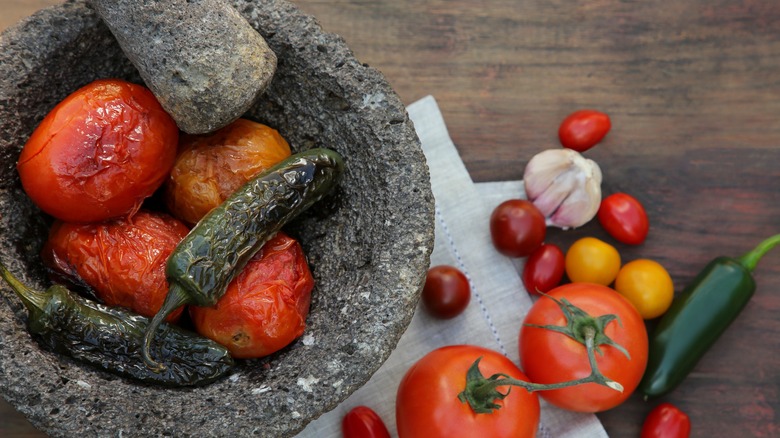The Subtle Difference Between Picante Sauce And Salsa
Adored for their array of punchy flavors and spice — salsa and picante sauce are staples in Latin American kitchens that have also been integrated into Tex-Mex and Mediterranean cooking. Although some might think these two are one and the same, several important distinctions exist between them.
The most important distinction between the two sauces is in the consistency. Salsa comes in numerous variations ranging from chunky pico de gallo to smoother salsa verde. Picante is only blended to a hot sauce-like texture. While both salsa and picante share many ingredients like tomatoes, onion, jalapeño, and spices, the difference in how these sauces are prepared is one of the chief distinctions between them.
Picante is made by chopping these ingredients up finely and puréeing them to create a proper condiment rather than a chunky dip. Picante's thin, almost creamy texture and heat makes it a popular choice for enchiladas and smothered burritos. Salsa, on the other hand, is typically prepared by chopping vegetables up coarsely and mixing them. As a result, salsa is a broad category encompassing a number of sauces with varying spice levels and flavors but a consistency perfect for snacking on with chips or on top of a plate of nachos.
What are salsa and picante?
Who can imagine a world without salsa? "Salsa" is simply Spanish for "sauce." The condiment is a cherished mainstay in many households, popularly used as an accompaniment for chips and as a garnish or side for main dishes. At its core, salsa is a spicy, seasoned tomato sauce.
The fresh, peppery dip invites many interpretations of the classic concept — salsa roja, corn salsa, and salsa verde, to name a few. One of its most enticing elements is its versatility. Home cooks can experiment with their own salsa recipes, and some commercially available jars are considered the best store-bought salsas.
The word "picante" means spicy in Spanish. True to its name, picante is a vegetable-based hot sauce essential to recipes like picante de huevos. Unlike salsa, picante doesn't vary much in its flavor. Although some mild picante sauces can be found, it is typically made to be fiery and hot. One variation from traditional picante sauce is seen in picante verde — which gets its color and heat from green chiles. Picante sauce in its liquid form makes it a wonderful topping to pour over comforting casseroles or to spice up tacos.
The history of salsa and picante
Salsa originated in the world of the ancient Aztecs. The original recipe, as depicted by a priest named Alonso de Molina in 1571, is a sauce composed of tomatoes, chiles, and squash seeds. Its timeless taste boomed in popularity in America as access became widespread. Bottled hot sauces and jarred salsas gained traction in the 20th century, and now salsa is one of the country's most popular condiments.
Picante is a more recent invention and has its origin in Tex-Mex cuisine. The spicy, smooth sauce, as we've come to know it, made its debut in 1947. Working with a few jalapeños, crisp onions, and smoothly puréed tomatoes, Louisiana-born Texan David Pace introduced the world to the first ever "Picante Sauce." Although picante sauce has its origins in Pace's special sauce, if you search for the sauce, you'll come across a variety of thinly puréed hot sauces.


